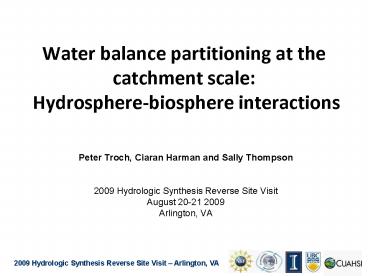Water balance partitioning at the catchment scale: Hydrosphere-biosphere interactions - PowerPoint PPT Presentation
1 / 33
Title:
Water balance partitioning at the catchment scale: Hydrosphere-biosphere interactions
Description:
Water balance partitioning at the catchment scale: Hydrosphere ... Donaldson Coniferous Forest. Morgan Monroe Mixed Forest. Poorly correlated. Well correlated ... – PowerPoint PPT presentation
Number of Views:41
Avg rating:3.0/5.0
Title: Water balance partitioning at the catchment scale: Hydrosphere-biosphere interactions
1
Water balance partitioning at the catchment
scale Hydrosphere-biosphere interactions
- Peter Troch, Ciaran Harman and Sally Thompson
- 2009 Hydrologic Synthesis Reverse Site Visit
- August 20-21 2009
- Arlington, VA
2009 Hydrologic Synthesis Reverse Site Visit
Arlington, VA
2
Motivation another Horton index
V Growing-season vaporization (ET) W
Growing-season wetting (P-S)
The natural vegetation of a region tends to
develop to such an extent that it can utilize the
largest possible proportion of the available soil
moisture supplied by infiltration (Horton, 1933,
p.455)
Horton, 1933 (AGU)
3
Horton Index vs. Humidity Index
Std. Horton Index
Mean Horton Index
53 with Std(H)lt0.06 74 with Std(H)lt0.07 83
with Std(H)lt0.08 93 with Std(H)lt0.10
Troch et al., 2009 (HP)
4
(No Transcript)
5
What controls the Horton index?
6
The Horton Index
Proportion of available water vaporized
Precip
Fast runoff
ET
Wetting
Slow runoff
Annual Evapotranspiration
HI
Annual Wetting
7
(No Transcript)
8
Three approaches explain HI
Pattern
Process
Function
HI
9
... all three predict the mean remarkably well
Uncalibrated
Calibrated
Pattern
Process
Function
10
HI was predictable based on static or mean
catchment properties
Pattern
Humidity index P/EP
HI f ( )
Mean Topographic Index ltLog (a / tan ß)gt
11
and using a conceptualization of annual
partitioning of precip
Function
P
S
ET
W
U
- Functional model
- ? S and U have thresholds
- ? ET and W have upper limit
- Functional model predicts mean, variance of HI
Wetting potential
Fast flow threshold
12
... and using a stochastic model based on
filtering of storm events.
Process
Calibrated
Uncalibrated
Storage capacity
Calibrated storage capacity
13
We gained insight into controls on HI
14
Regression models suggest that climate and
topography are primary controls
Pattern
CV HI
Mean HI
Topographic Index
Humidity Index
Humidity Index
Mean Climate (except in steep, arid
regions) CV topography (humid regions)
15
Functional model suggests catchment capacity to
vaporize and store water are basic controls
Function
P 1000mm
?s ?u 0.05
Ep
?s ?u 0
Mean - vaporization potential ( energy)
- catchment wetability (to a point)
16
- Process model also suggests keys are that climate
and capacity to store water from storm events
Process
Mean HI Humidity Index, storage
capacity Variance only sensitive in arid regions
17
Prediction of interannual variability opens up
questions about other factors
Pattern
Process
Function
Timing of rainfall, vegetation response,
landscape change, ?
18
Key unresolved questions
- How does variability scale in time?
- What timescales are important?
19
Key unresolved questions
- What is the role of vegetation in hydrologic
partitioning? - Are we only able to make predictions because of
the co-evolution of vegetation, soils and
geomorphology constrained by climate, geology and
time?
Vegetation paradox HI predicts vegetation
(NDVI) Much of the ET is T No models account
for vegetation explicitly!
20
Variability and Vegetation
- Learning from Data-Rich Sites
21
Working Paradigm
- Classic ecohydrological approach ETmax
f(Rn, VPD, LAI,T) - ET ETmax f(?)
- Water-limited paradigm? Plant control of ET?
22
A Parsimonious Model
Rn
VPD
LAI
U
P
T
Penman Monteith Model
PPT
Interception Model
E
Emax
Infiltration
Runoff
Multiple Wetting Front Model
T
Root Water Uptake Model
Drainage
23
Interannual variability
24
Sub-daily variability
ET (mm/hr)
25
Seasonal variability
ET (mm/hr)
- Month
26
Soil Moisture Drydown v ET
ET correlates to soil moisture
Kendall
ET (mm/hr) or ?
Days
ET increases as soil moisture declines!
Sky Oaks
ET Soil Moisture
ET (mm/hr) or ?
Days
27
Adding Groundwater Improves Prediction
ET (mm/hr)
- Month
28
Phenology Changes Seasonality of ET
Howland Forest, Maine
C
B
Normalized ET, LAI and Rn
C
B
A
A
Week
29
Phenological Effects are Predictable
ET v Cumulative Growing Degree Days for first 150
Days of the Year
Kendall Grasslands
Donaldson Coniferous Forest
Morgan Monroe Mixed Forest
Poorly correlated
Well correlated
Onset of plant growth? Or leaf maturity?
30
Can Patches Predict Catchments?
Sky Oaks
S.O. Catchment
Morg. Monroe
M.M. Catchment
Horton Index
Harvard Forest
H.F. Catchment
Goodwin Crk.
G.C. Catchment
Humidity Index
31
Conceptual Upscaling Approach
- Multiple Buckets different topography, veg,
soil etc.
ET, Energy, C
PPT, Energy, C
Surface redistribution
Deep Drainage, Water Table, Lateral Redistribution
32
Ecohydrological catchment classification?
Donaldson
Sky Oaks
Harvard Forest
Kennedy
Morgan Monroe
Austin Cary
HuI Radiation Phenology GW Access Seasonality
Metolius
Howland Forest
Fort Peck
Goodwin Creek
Kendall
0.5
1
1.5
0
Humidity Index
33
Discussion Points
- What does all this mean for predicting water
cycle dynamics in a changing environment? - Mean behavior of hydrologic partitioning is
surprisingly predictable, and - Knowing hydrologic partitioning improves
prediction of vegetation response, yet - The inter-annual variability is poorly understood
and calls for higher understanding of ecosystem
control on water cycle dynamics (do we need to
replace the old paradigm?)































